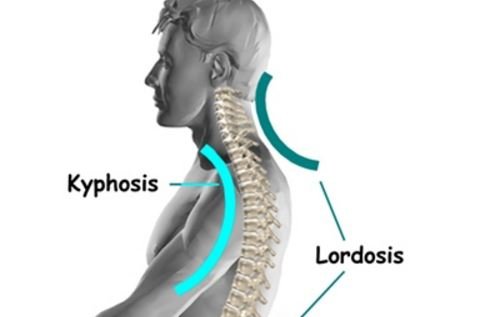Cervical Lordosis
What is Cervical Lordosis?
Cervical lordosis refers to that slight inward curve within the cervical spine that encompasses the 7 cervical vertebrae of the neck. This is a normal neck curve and very advantageous to get both the head and the spine be in a stabilized position without any discomfort.

The cervical spine is considered healthy with its slight lordotic curve and the anatomical position is significant in its role to support the weight of the head. The problem will just arise in relation to cervical lordosis when there will be a straightening of the curve or in instances where the curve can be going into a different direction; it can also be an excessive forward curve of the neck which can lead to pain, feelings of strain or any possible complications.
It has to be noted that an excessive spinal curve of the neck, with the main characteristic of an exaggerated C-shape of the upper back of a person or a noted straightening of the normal curve, located just below the skull region is a case of cervical lordosis.
Signs and Symptoms of Cervical Lordosis
People who have cervical lordosis curve problem may not manifest the clinical symptoms at times until it becomes worse, requiring management of pain or even surgery. A cervical lordosis curve that is lost or misaligned can result to the following symptoms:
- Neck and back pain
- Neck stiffness
- Vertigo and nausea
- Headache and tinnitus
- High blood pressure
- Insomnia and fatigue
- Nervousness and confusion
- Numbness or tingling sensation in the neck

Causes of Cervical Lordosis
There a lot of predisposing factors which may lead to problems of a healthy spine in cervical lordosis and these are:
- Inherited condition as taken from genes with degradation problem of the spinal column as a person’s age increases
- Injury or trauma to the neck
- Stress and strain to the neck
- Slouching due to failure to maintain good posture, especially with prolonged sitting or standing
- Osteoporosis where bones undergo some degradation in the spine
- Obesity is approximately affecting about 90% pf obese people because of strain in the back to support an excess weight
How is Cervical Lordosis Diagnosed?
The physician performs a thorough physical examination of the patient based on the clinical manifestations and history taking done. The diagnosis associated with some anatomical changes with cervical lordosis is confirmed through procedures like X-rays and magnetic resonance imaging.
How is Cervical Lordosis Treated?
An early assessment and diagnosis of an existing cervical lordosis problem paves the way for immediate medical interventions to be done, utilizing available treatment options and preventing possible complications.
Reversal techniques
Reversal techniques for cervical lordosis have to be done for the following reasons:
- Achievement of correct posture
- Prevention of spinal injury
- Prevention of inadequate supply of oxygen and nutrients going to the brain
- Prevention of osteoporosis due to spine misalignment
Exercises
Exercises can also be done to reverse cervical lordosis and improve the straightened position of the neck and spine curvature through:
- Neck flexion – Gentle flexing of the neck back and forth, similar to a nodding action
- Neck retraction – Keeping a forward-facing stance and retracting the neck just enough to feel the stretch and holding it for 5 seconds
- Neck extension – Lifting head to the ceiling and the head tilted back for about 5 seconds and back to an upright position
- Upper neck nodding – Lying flat on the floor and pushing gently the back of the neck towards the floor, then lifting the head about an inch distance from the floor watching the feet direction, holding for 5 seconds and back to position

Medical approaches
Medical approaches for the reversal of cervical lordosis:
- Physical therapy aimed at gaining back good posture
- Chiropractic therapy for correct body posture
- Use of support pillows during sleeping time to stabilize the neck
- Use of special traction wedges at home to correct the neck curve problem
- Application of orthotics so that correct posture can be maintained during prolonged standing and walking
- Surgery for spinal fusion is the last resort for some patients to resolve the problem of cervical lordosis due to some risk and possible permanent changes in the lifestyle of an affected person

References
- Do You Suffer From Loss of Cervical Lordosis?, So Why Do We Need These Curves In Our Spine? How Is It Harmful To The Body If They Are Abnormal? at http://www.drkarencann.com/2011/08/31/do-you-suffer-from-cervical-lordosis/
- http://healthbooklet.hubpages.com/hub/The-Importance-of-Reversal-of-Cervical-Lordosis
- Exercises to Do at Home for Cervical Lordosis at http://www.livestrong.com/article/168698-exercises-to-do-at-home-for-cervical-lordosis/
- Harrison, D.E., Harrison, D.D., Colloca, C.J., Betz, J., Janik, T.J., Holland, B. (2003). Repeatability of posture overtime, x-ray positioning, and x-ray line drawing: an analysis of six control groups. J Manipulative Physiol Ther.26:87–98.
- Harrison, D.E., Harrison, D.D., Haas, J.W. (2002). CBP Structural rehabilitation of the cervical spine. Harrison CBP Seminars, Inc., Evanston (Wyo). 42–45.
- Gore, D.R. (2001). Roentgenographic findings in the cervical spine in asymptomatic persons. A ten-year follow-up. Spine. 26:2463–2466.
